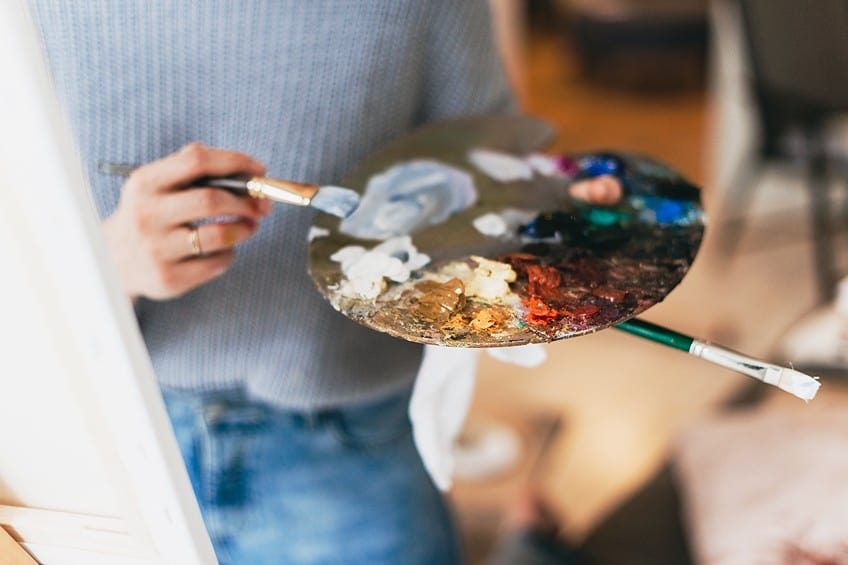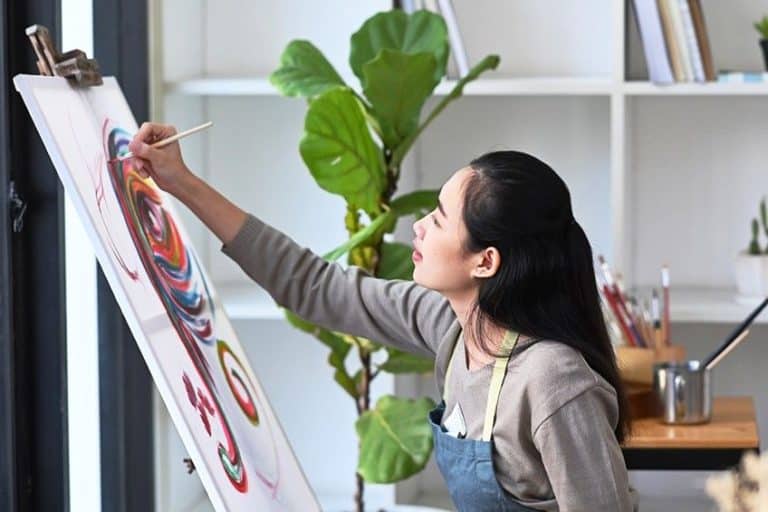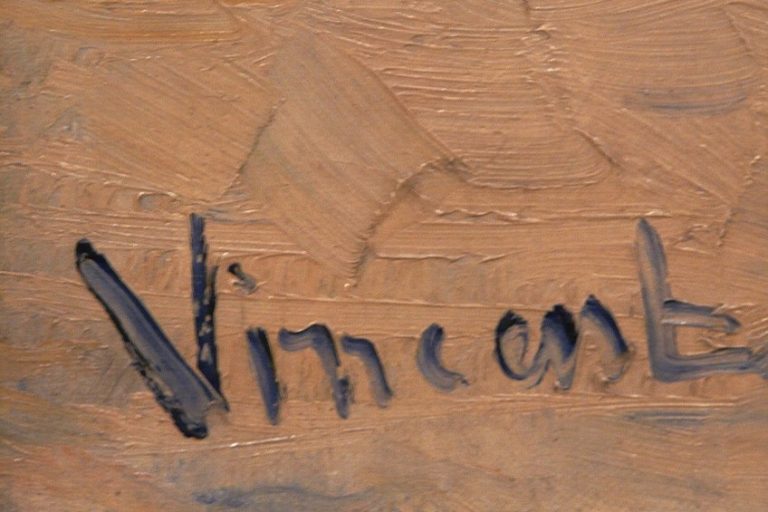How to Become an Artist – A Complete Guide to an Art Career
Have you ever thought about becoming an artist for a living? Even if you have never seriously tried to give it a go, getting into art can be fun, fulfilling, and possibly even financially lucrative. But, it can be challenging to know how to become a professional painter if you have no prior experience or knowledge on the subject. If you want to find out how to be an artist and how to start an art career, then keep reading below!
How to Become an Artist and Make Money From It
Many people assume that certain skills like being able to make music or art are genetically inherited and that some people are simply born with these talents. However, this is not true, and as with any other skill, the ability to create great art comes with practice! The beauty of getting into art is that you don’t necessarily need to fork out large sums of money to acquire the needed skills.
There are many ways that people can learn how to become an artist, such as through apprenticeships, or even by teaching themselves using online resources.
What Is an Artist?
The first step to becoming an artist is finding out what an artist actually does. Sure, we all know that artists are people who create beautiful artworks, but how does that translate to a career in the modern world? While we might associate the word “artist” with more traditional art forms such as painting and sculpture, today it encompasses a far greater range of potential professions to explore. You could choose to be a more traditional freelance type of painter that works through private commissions or a full-time graphic designer earning a monthly salary. It all really depends on what kind of hours you would like to work and the type of salary you hope to earn.
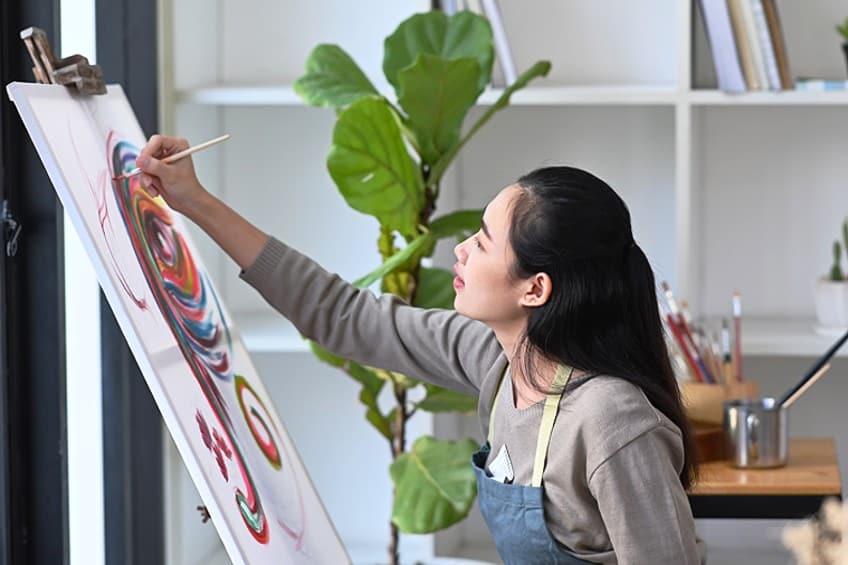
Types of Careers for Artists
There are many different spheres of art that one could pursue a career in, ranging from architecture to painting, cinema, theater, sculpture, digital design, photography, art framing, curating, art teaching, concept art, and even art therapy. Concept artists often envision and create media such as sketches, drawings, and paintings of buildings, cars, characters, and locations.
Concept artists work in industries such as graphic design, advertising, print publications, architecture, animation, and video games. Many concept artists work from home, whereas others work in offices.
Illustrators typically work alongside authors to produce artworks that are used to illustrate books and other printed works. They usually work from one contract to another, although they can also work for media publications and advertising agencies. A graphic designer creates artwork for a range of applications. Graphic designers can find work in sales, marketing, manufacturing, and entertainment. Graphic designers create advertising materials, logos, short animations, and other computer-aided designs based on customer specifications.
Finding Your Niche
With so many different types of art to choose from, how does one find a niche to work in? Start by trying out various art disciplines like painting, sculpture, photography, digital art, and others. Enroll in classes, seminars, or online tutorials to gain some experience with a range of different methods and mediums. Think about what subjects, concepts, or styles typically appeal to you. As you progress, you will start to feel a natural inclination towards a certain medium or style. Over time, you will notice that certain techniques and themes speak to you on an intellectual and emotional level, and you will start to develop your own distinct style. Once you discover your niche, then it’s just a case of finding a field of work that necessitates your certain skill set, or you may choose to work for yourself and offer your art online.
Art Education and Training
Once you have found a specific niche, you might decide that you would like to learn more about your chosen medium by enrolling at an art school. These types of lessons can range from full-on college courses to part-time evening classes, it really depends on how much time and money you can afford to invest in these studies. While you can also choose to teach yourself how to make art by watching online tutorials or simply through practice, there are several benefits to studying at a formal art institute.
Art institutes provide a structured program that can help you improve your artistic talents and knowledge. The faculty members often work as artists themselves and have years of experience.
They can provide helpful advice, critiques, and mentorship. Art institutes are able to provide access to specific resources and facilities that may be difficult to obtain on your own. Having access to these resources enables you to play around with various mediums and approaches and learn about the kinds of tools and machinery you will be working with in your chosen field. Another way that you can learn about the techniques and equipment used in the industry is through an apprenticeship. The benefit of an apprenticeship is that it is a very hands-on way of learning the ins and outs of the industry, without any of the unnecessary parts that they add to formal curriculums to pad out the duration of the course.

If you are not interested in learning about art theory or history and prefer to learn about the practical aspects of the job, then perhaps an apprenticeship would serve you better than a formal course.
Developing Your Skills as an Artist
If you choose to go the self-education route, then there are still some techniques that you can incorporate on a daily basis to develop your skills. The most important thing that any artist can do is continually practice improving their techniques. Regular practice aids in the development of muscle memory, hand-eye coordination, and technical abilities. It allows you to effectively realize your artistic visions with greater control and precision. Every different artistic medium has a unique set of characteristics, challenges, and techniques associated with it.
Regular practice allows you to grow thoroughly acquainted with your chosen medium. With consistent experimentation and practice, you will learn how to effectively manipulate your medium and eventually how to overcome the challenges it presents.
Techniques for Improving Your Skills
Besides simply practicing, there are also several other techniques that we can recommend that will help you improve as an artist. Examine the work of artists you appreciate to gain a deeper understanding of their skills. Observe how they employ color, brushwork, composition, and other aspects of art. Pay attention to the artistic decisions they made and how they were able to create certain visual effects. This observational study could potentially provide you with fresh ideas and impart specific techniques that you can apply to your own art. Develop creative exercises that are specific to the areas of your art that you would like to see improve. You may, for instance, practice still life studies, gesture drawing, or rapid drawings if you wish to enhance your drawing abilities.
If you want to enhance your brushwork, consider experimenting with different brushwork techniques or producing new textures. These targeted exercises assist you in identifying and developing key skills.
Other people’s feedback, such as that of fellow artists or teachers, could provide significant insights into your artwork. They may offer ideas for improvement, point out aspects where you shine, or offer a different point of view. It’s important to be receptive to constructive criticism and to use it to help you develop and improve as an artist. Use the multitude of online courses, YouTube tutorials, e-books, and other online resources at your disposal to learn new techniques and broaden your skill set. These tools often include step-by-step instructions, examples, and descriptions of many artistic techniques.
Building Your Art Portfolio
Your art portfolio serves as a collection of artworks that best represent your style and quality. It provides a visual representation of your specific abilities, creativity, and aesthetic flair. Your portfolio’s purpose is to present a complete and unified overview of your artistic output, exhibiting your creative ability and distinctive vision to prospective customers, galleries, or art schools. Depending on the target audience and context, your art portfolio can be rendered in a multitude of mediums. They might be physical portfolios with printed images or tangible artworks, or digital portfolios with digital artworks shown online on various websites or digital platforms.
Some artists choose to make digital as well as physical copies of their portfolios so that they have something to show no matter what situation they find themselves in.
What to Put in Your Portfolio
A well-chosen selection of artworks that showcase the artist’s talents, and style should be included in the portfolio. It is crucial to select an array of pieces that demonstrate your diversity and proficiency in various styles, subjects, or materials. The format of the presentation, whether digital or printed, should be of excellent quality. Physical artwork should ideally be shot professionally or scanned in order to accurately depict the original piece of art. Digital portfolios should include high-resolution photos that highlight the artwork’s subtleties and intricacies. Pay close attention to the framing, lighting, and composition so that your artwork is portrayed in the best manner possible. A brief description for each piece could offer people insight into your creative process, motivation, and intentions.
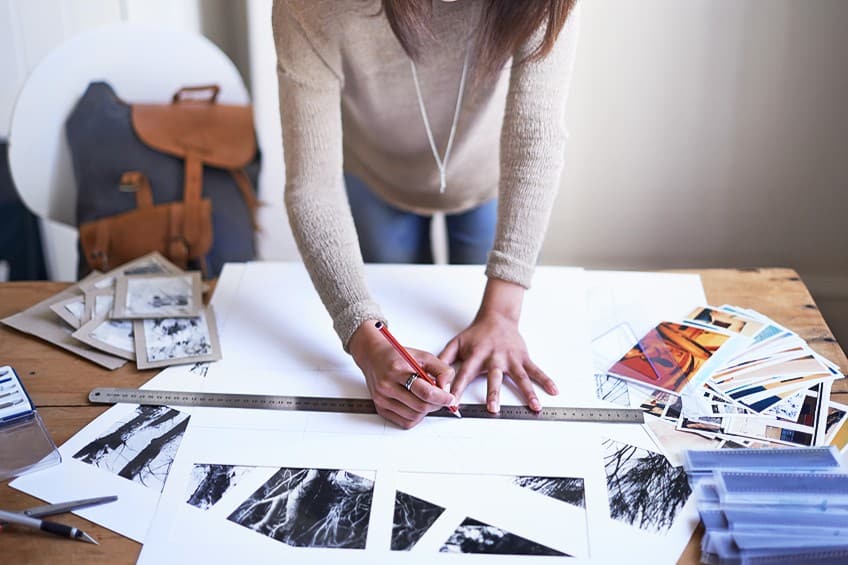
Using Social Media to Showcase Your Work
For many artists today, the thought of lugging around a physical portfolio almost seems outdated and unnecessary. This is because so many of them use digital platforms and social media to share their artworks with the public and prospective clients. There are many great platforms available that allow artists to upload and exhibit their work online. However, it can be easy to get lost among all the other artists on the platform, therefore, some artists prefer to create their own websites. The only challenge with having your own website is getting people to visit it when you first start out. Digital art platforms work well for many artists, as these existing platforms already enjoy large amounts of traffic.
Other artists create pages on sites such as Instagram, where people are able to engage with the artists and deal with them directly instead of through a shop or online vendor.
The Business Side of the Artworld
If you want to compete in the art business, you must be online. One can build a basic website with a website builder such as weebly.com, wix.com, or SquareSpace.com, which all provide free versions with a few basic layouts to select from. They are adequate for the early stages of your profession, but at some point, you will need a more professional-looking site. Once you have created the art, made a portfolio, and designed your website, you can begin the next stage, which is to build your resume of work. This entails entering local exhibitions or joining local art clubs and participating in group exhibitions. Working with little local venues such as a library or coffee shop that displays local art is another option. Now is the time to put your work out there in the real world.

Marketing Yourself and Your Work
After you’ve accumulated some presentation history, it’s time to beef up your website and create some marketing materials. You’ll need an artist statement as well as a biography. A professional-looking headshot that reflects your creative personality is also essential. An artist statement is what you wish to communicate with your artwork. It is what distinguishes your works of art or what you want people to feel when seeing what you have created. A biography is basically a summary of your history as an artist (education, exhibitions, and so forth). Save these materials as shareable documents and put them on your website as well.
You should also have a good understanding of pricing your art at this stage. You need to be able to pay your expenses, but you also cannot overcharge when you are first starting out.
Price rises should be gradual or follow a specific award or professional relationship. Finally, business cards are still widely used today. They provide your website URL so that visitors may view more of what you do or contact you. They’re great for on-the-spot marketing. Becoming an artist professionally entails more than merely achieving specific goals. It also refers to how you present yourself. It’s the way you conduct yourself, and how confident you are in your profession. Dress smartly, show up neat and tidy, and display your artwork in the best light when engaging in the art world. Make sure your marketing materials appear professional.
Navigating the Art Industry
It’s important to keep up to date with current trends and advancements in the art industry. You can better understand the current trends in the art world by reading art magazines, following art blogs, and signing up for newsletters covering the art world. This will provide you with information on new artists, art collectors’ preferences, and the dynamics of the market. You should also regularly explore the art galleries and art fairs in your neighborhood. Observe the different kinds of artwork on display, make note of the predominant styles, subjects, and media, and pay close attention to how other artists place and exhibit their creations.
Attending exhibits allows you to immerse yourself in the art world, learn about different artistic methods, and converse with other artists, gallery curators, and art lovers.
The Role of Art Galleries and Dealers
Artists often turn to art galleries and dealers to try and promote their work, interact with potential customers, and understand the art market. Art galleries are real or virtual locations where artwork is displayed and sold. They arrange exhibits that often showcase the works of numerous artists at once. Art dealers operate as go-betweens for artists and collectors. They are art market experts who help collectors build their art collections. Contacting galleries and dealers about exhibiting your art can be both thrilling as well as challenging.
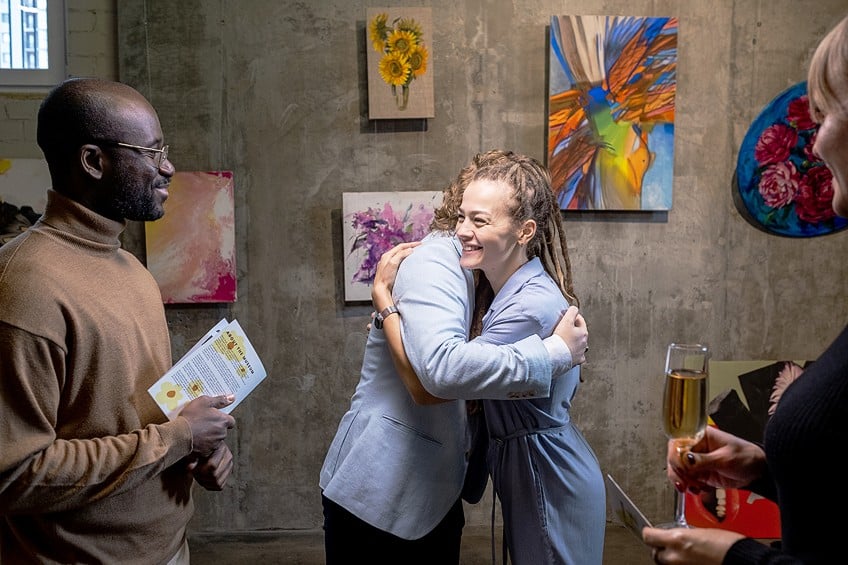
Go out of your way to find galleries and dealers who share your artistic style and are willing to take on works from someone early on in their artistic career. Look for galleries that have a history of exhibiting artists like you or who exhibit artwork that speaks to you on a personal level. Send professional and individualized emails to various galleries and dealers. Introduce yourself and explain that you are interested in displaying your art at their gallery. Attach a PDF of your portfolio or send a link to your website. Visit the galleries that most appeal to you and visit their events in person. This will enable you to become better acquainted with their programs, network with gallery personnel, and show interest in what they do.
Establishing connections with gallery personnel could prove beneficial in the long run.
Networking and Building Relationships in the Art Industry
As we mentioned above, getting to know the gallery personnel can prove very beneficial in the long run. In fact, building relationships with other people in the industry and networking with them is essential if you wish to be a part of the community in which you work. If you hope to build relationships within the industry, it’s important to attend art exhibits, art fairs, gallery openings, and other art-related activities in your region on a regular basis. Engage in discussions, ask questions, and demonstrate a genuine interest in the work of others. Personal relationships may result in future collaborations, exhibits, or even client referrals.
Look for opportunities to work on cooperative projects or exhibits with other artists. Collaborations enable you to pool resources, exchange knowledge, and broaden your network. Follow up with an email after meeting someone in the industry.
Keep in touch with your connections, bringing them up to speed on your artistic activities and chatting about what they’re doing as well. Building long-term partnerships requires consistent effort, but consistency is key when it comes to making it in the art world. Remember that networking in the arts is about more than just self-promotion; it is mostly about making genuine connections, helping others, and giving back to the art community. In your relationships, be genuine and respectful, and welcome opportunities to learn from and work together with others.

It takes time to build a solid network, so be persistent and patient in establishing connections that can help move your artistic career forward. Chat with the other artists at the shows you attend. Get a sense of how their career choice affects their lives. Every different type of art event will have its own challenges and demands. For example, they may tell you that in order to get representation in galleries, you will need to develop a personal connection with gallery owners. Travel will be required for plein air competitions, so that is something you might need to consider. Contracts as well as ways of effectively communicating with clients will be required for commission work.
Outdoor markets will necessitate travel as well as the purchase of suitable tents and mounting supplies. Take notes and ask questions. Some will inevitably appeal to you more than others.
Overcoming Common Challenges in the Art World
While it may seem that becoming an artist for a living means calling your own shots and doing what you love, there are also many challenges that artists face on a daily basis. These challenges include having to deal with the inevitable rejection of your work from galleries and clients, dealing with creative blocks, and learning how to balance art with the rest of your life.
However, every industry comes with its challenges, so rather than be disheartened by them, let’s see what can be done to deal with these challenges.
How to Deal with Rejection in the Art Industry
Rejection is an everyday occurrence in the art world, and learning to deal with it constructively is critical for your long-term artistic growth and eventual success. Reframe rejection as a chance to hear criticism and learn rather than a negative outcome. It’s important to recognize that art is very subjective and that every opportunity comes with its own requirements or restrictions. Adopt a growth mentality, which maintains that skills and abilities can be acquired via hard work and devotion. It’s far better to think of rejection as a stepping stone to success instead of an indication of your self-worth or artistic ability.
Overcoming Creative Blocks
Artists consider creative blocks to be one of the worst things that can happen to them. Nothing is worse than having a head full of ideas, but once you sit down to work, you suddenly draw a blank or feel very uninspired. Stepping away from your work for a bit might sometimes bring a new perspective. Take a little pause or do something else to enable your mind to rest and refuel. This can help reduce tension and provide room for new thoughts to arise. Surround yourself with inspirational creativity in all forms. Play some music, watch a movie, or visit a gallery. Engaging with various types of art and the environment around you may boost your creativity while sparking new ideas. Divide your creative endeavor into smaller, easier-to-accomplish tasks.
Focusing on attainable goals might help to relieve stress and make the process feel less daunting. As you complete each minor task, you will start to gain momentum.
Balancing Art With Life
Working the whole time is a surefire way of eventually burning out or hitting creative dead-ends. It is essential to reach a balance between your work as an artist and the rest of your life. Without this balance in place, both your work and your life will suffer. In order to be in a frame of mind that is receptive to creativity, you must be properly nourished, you require daily exercise, and you need to work in a clean environment. Therefore it is important to set aside time in your day to make sure you are healthy, clean, and mentally ready to take on creative tasks. Art also requires inspiration, and the best place to find inspiration is by living life.
Whether you want to learn how to become a professional painter, graphic designer, concept artist, or photographer, there are certain guidelines that will help you achieve your goals. In this article, we explored how to be an artist in today’s industry by following a few simple steps. These steps to becoming an artist include studying or completing an apprenticeship, building a portfolio, increasing your online presence, and engaging with the industry. Now that you know how to start an art career, what field are you thinking of entering?
Frequently Asked Questions
Is Getting into Art as a Career Hard?
There are many sectors that require artists on a daily basis. Getting into art has actually never been easier, as we now have the internet to help artists showcase their works without having to exhibit in a gallery. There are many ways to learn the arts as well, from formal training to educating yourself via online resources or books.
What Are the Cons of Becoming an Artist?
Many artists are self-employed, which means that work is not always consistent. Trends change often, so you might also find yourself in a market that does not appreciate your specific style. You might be able to get a full-time position for a company, but as with any job, working from a client’s brief will often require that you create art that does not necessarily interest you.
Nicolene Burger is a South African multi-media artist, working primarily in oil paint and performance art. She received her BA (Visual Arts) from Stellenbosch University in 2017. In 2018, Burger showed in Masan, South Korea as part of the Rhizome Artist Residency. She was selected to take part in the 2019 ICA Live Art Workshop, receiving training from art experts all around the world. In 2019 Burger opened her first solo exhibition of paintings titled, Painted Mantras, at GUS Gallery and facilitated a group collaboration project titled, Take Flight, selected to be part of Infecting the City Live Art Festival. At the moment, Nicolene is completing a practice-based master’s degree in Theatre and Performance at the University of Cape Town.
In 2020, Nicolene created a series of ZOOM performances with Lumkile Mzayiya called, Evoked?. These performances led her to create exclusive performances from her home in 2021 to accommodate the mid-pandemic audience. She also started focusing more on the sustainability of creative practices in the last 3 years and now offers creative coaching sessions to artists of all kinds. By sharing what she has learned from a 10-year practice, Burger hopes to relay more directly the sense of vulnerability with which she makes art and the core belief to her practice: Art is an immensely important and powerful bridge of communication that can offer understanding, healing and connection.
Nicolene writes our blog posts on art history with an emphasis on renowned artists and contemporary art. She also writes in the field of art industry. Her extensive artistic background and her studies in Fine and Studio Arts contribute to her expertise in the field.
Learn more about Nicolene Burger and the Art in Context Team.
Cite this Article
Nicolene, Burger, “How to Become an Artist – A Complete Guide to an Art Career.” Art in Context. July 7, 2023. URL: https://artincontext.org/how-to-become-an-artist/
Burger, N. (2023, 7 July). How to Become an Artist – A Complete Guide to an Art Career. Art in Context. https://artincontext.org/how-to-become-an-artist/
Burger, Nicolene. “How to Become an Artist – A Complete Guide to an Art Career.” Art in Context, July 7, 2023. https://artincontext.org/how-to-become-an-artist/.


